Posted by Elena del Valle on July 13, 2012
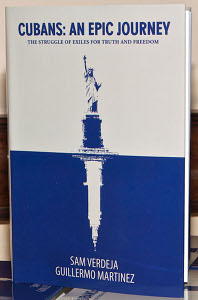
Cubans book cover
Photos: Facts About Cuban Exiles
Six women and twenty-five men contributed forty essays to Cubans: An Epic Journey (Reedy Press, $27.92), a 782-page softcover book with a 16-page photo section about their impressions of the South Florida Cuban exile experience from the 1950s until today published with the support of Facts About Cuban Exiles (FACE) with the sponsorship of John S. and James L. Knight, The Armando Codina Family, First Bank of Miami, Carlos Migoya, and Riteway Properties.
In the Introduction, the authors say that Cubans in the United States represent 3.5 percent of the Hispanic American population or approximately 1.8 million people. They explain that the largest concentration of Cubans (55 percent) lives in Greater Miami, Florida and describe the Miami community as having established a “parallel mainstream” where they “can sustain a refined culture – creating and preserving its own music, food, literature, theater, cinema, radio and television.”
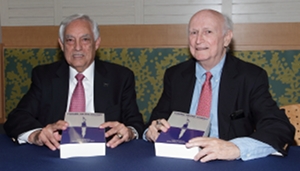
Sam Verdeja and Guillermo Martinez, editors, Cubans
The work was edited by Sam Verdeja, a magazine publisher, and Guillermo Martinez, a print and broadcast journalist. In addition to Verdeja and Martinez, Cesar Pizarro, a newspaper executive, Howard Kleinberg a newspaper editor, Louise O’ Brien, a business executive, Leonardo Rodriguez, a university professor and Francisco Rodriguez, a broadcast commentator participated in the project. Other contributors include Jose Cancela, Eloy Cepero, Raul Chao, Juan Clark, Olga Connor, Carlos Curbelo, Rogelio de la Torre, Sonia Frias, Jose Garrigo, Armando Gonzalez, Jose Irastorza, Federico Justiniani, Aida Levitan, Roly Martin, Rene Murai, Olga Nodarse, Marcos Antonio Ramos, Alejandro Rios, Raul Rodriguez, Rene Rodriguez, Silvia Unzueta, Enrique Viciana, Alberto Vilar, and Eduardo Zayas-Bazan.
The book is divided into 39 chapters in two major sections, The History in the first 16 chapters and The Exile Experience in the remaining chapters, as well as an Epilogue and five appendices. The second section of the book is subdivided into Business and Finance; Arts, Entertainment, and Religion; Media and Advertising; Professionals; and Political, Civic and Social Life.

Click to buy Cubans
Comments:
Filed Under: Books
Posted by Elena del Valle on July 11, 2012

A scene from Bartali
Photos: Vme
In 2006, Rai Fiction and Endemol produced Bartali in Italy about Gino Bartali, an Italian cyclist who won the Tour de France twice. Directed by Alberto Negrin starring Pierfrancesco Favino, Simone Gandolfo, Nicole Grimaudo and Carlo Giuffre with a musical score by Ennio Morricone, described in promotional materials as one of the most influential film music composers of the 20 century, Bartali will air as a four-part miniseries on Vme beginning at 9 p.m. ET/PT July 16.
Dubbed into Spanish it may be the first time the series is airing in the United States. The program is scheduled to air for four nights and each episode is two hours long. Favino plays Gino Bartali while Grimaudo plays Adriana Bartali, Gandolfo plays Fausto Coppi and Giuffre plays Cardinale Dalla Costa.

A scene from Bartali
As a youngster Bartali nearly abandoned cycling following the death of his brother Giulio in a race. He continued cycling with the help of his brother Leone and his faith. In 1938, he won the Tour de France in honor of his brother’s memory.

A scene from Bartali
A devout Catholic, Bartali’s religious and moral beliefs led him to use his cycling talents to assist his friend Cardinal Dalla Costa and the Italian resistance during the war. In 1948, Italian Prime Minister De Gaspari asked Bartali to help ease political tensions by winning the Tour de France again and he did. Many historians believe, according to promotional materials, that the national enthusiasm that resulted from his second victory helped prevent a civil war.
Vme, a 24-hour Spanish language network partnered with public television stations, offers drama, music, sports, news, current affairs, food, lifestyle, nature and educational preschool programs. The network estimates it reaches more than 10 million Hispanic homes. Vme is the first venture of the media production and distribution company, Vme Media, Inc.
Posted by Elena del Valle on July 9, 2012
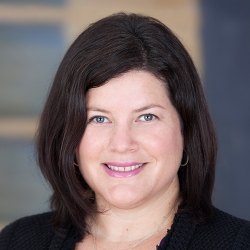
Amanda Fernandez, vice president, Latino Community Partnerships, Teach For America
Photo: Teach For America
A podcast interview with Amanda Fernandez, vice president, Latino Community Partnerships, Teach For America is available in the Podcast Section of Hispanic Marketing & Public Relations, HispanicMPR.com. During the podcast, she discusses educational inequity with Elena del Valle, host of the HispanicMPR.com podcast.
Amanda leads Teach For America’s Latino Initiatives that support outreach to the Latino community and recruitment, advancement and development of Latino corps members and staff. She brings over 20 years of experience in recruiting, diversity, organization development, change management and Latino community relations. Amanda manages national partnerships and outreach activities with Latino serving organizations and institutions. In addition, she guides and leads efforts focused on Latino staff initiatives and across program teams within Teach For America.
Prior to joining Teach For America, Amanda was a director at The Bridgespan Group where she served as an organizational consultant to youth and education clients in support of their strategic planning efforts.
To listen to the interview, scroll down until you see “Podcast” on the right hand side, then select “HMPR Amanda Fernandez” click on the play button below or download the MP3 file to your iPod or MP3 player to listen on the go, in your car or at home. To download it, click on the arrow of the recording you wish to copy and save it to disk. The podcast will remain listed in the July 2012 section of the podcast archive.
Posted by Elena del Valle on June 29, 2012
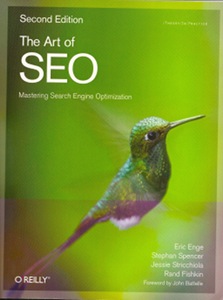
The Art of SEO book cover
Is search engine ranking an art or a science? What is the secret? Opinions vary and the answers are elusive at best. Yet, many continue to seek them because of the power they provide those who find even a fraction of success. In August 2011, people performed 158 billion online searches (comScore) and that same month 1.3 billion souls each relied on a search engine search.
Toward deciphering the ever changing secrets of search engine optimization (SEO) four experts combined years of knowledge and insights in search engine optimization to compile the second edition of The Art of SEO Mastering Search Engine Optimization (O’Reilly, $49.99), a 688-page softcover book published March of this year. Eric Enge, founder and chief executive officer, Stone Temple Consulting; Stephan Spencer, founder, Netconcepts; Jessie Stricchiola, founder, Alchemist Media, Inc.; and Rand Fishkin, chief executive officer and cofounder, SEOmoz, are the authors.
Although they identify anyone involved in the search engine optimization process at any level, especially web developers, development managers and marketers, as the target audience for the book judging by the size and complexity of some of the sections the book is not for the faint of heart or those who lack time to read. The authors promise to address updates on recent changes in search engine behavior like ranking methods requiring user engagement and social media; insights on insider SEO issues; the inner workings of search engines; the role of social media, user data, and links; how to track results and measure success; understanding how changes to a site may confuse search engines; building an SEO team; and future trends.
They point out that online searches, many on Google, reach 88 percent of people in the United States and billions internationally. They go on to outline that the dominant search engines in July 2011 were, in descending order, Google (65 percent), Yahoo (16 percent), Microsoft (14.4 percent), Ask (2.9 percent) and AOL (1.4 percent); and that in August 2011, searches were generally of one (25.8 percent) or two words (22.8 percent). Keeping abreast of search engine changes requires constant monitoring and adaptation and being an early adopter is essential, they point out. At the same time the long delay between adopting search engine optimization strategies and seeing results can be daunting; measuring results is important and can influence future budget decisions, they point out in a later chapter.
The tome is divided into 14 chapters with a very brief conclusion at the end of each: The Search Engines: Reflecting Consciousness and Connecting Commerce; Search Engine Basics; Determining Your SEO Objectives and Defining Your Site’s Audience; First Stages of SEO; Keyword Research; Developing an SEO-Friendly Website; Creating Link-Worthy Content and Link Marketing; How Social Media and User Data Play a Role in Research Results and Rankings; Optimizing for Vertical Search; Tracking Results and Measuring Success; Domain Changes, Post-SEO Redesigns, and Troubleshooting; SEO Research and Study; Build an In-House SEO Team, Outsource It, or Both? and An Evolving Art Form: The Future of SEO.

Click to buy The Art of SEO
Comments:
Filed Under: Books
Posted by Elena del Valle on June 27, 2012
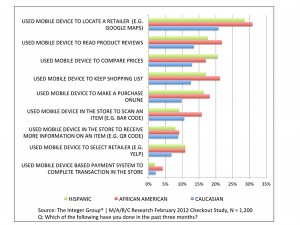
African Americans, Hispanics adopting mobile shopping behaviors – click to enlarge
Photos, chart: Network Communications
With the increasing popularity of smartphones (mobile phones that combine the features of a cell phone and a computer) and mobile devices marketers want to know if mobile buying behaviors are prevalent among the owners of these gadgets. Estimating that smartphone penetration is nearing 50 percent in the United States, in February 2012, The Integer Group and Marc Research surveyed 1,200 people online, in English, as part of an ongoing shopper behavior study.
One of the salient findings of their survey was that African American and Hispanic shoppers who participated in the survey appear to adopt shopping technologies at a faster rate than Caucasian (non Hispanic white) respondents. Among survey takers 18 percent of African American shoppers and 16 percent of Hispanic shoppers said they use their mobile device to make purchases compared to 10 percent of non Hispanic whites.

Martin Ferro, senior account planner, Velocidad
One in five African American shoppers (21 percent versus 13 percent of Caucasian shoppers) said they use their phone to read product reviews and maintain shopping lists, and one in five Hispanic shoppers (20 percent versus 13 percent of Caucasian shoppers) said they use their mobile device to compare product prices. The researchers believe that in spite of lower smartphone penetration among African Americans and Hispanics than Caucasians, the two ethnic groups, and women shoppers in particular, are using mobile phones as shopping aids.
“Basic mobile communication through SMS and mobile websites should be the points of entry. Mobile marketing to multicultural shoppers is a huge opportunity,” said Martin Ferro, senior account planner, Velocidad, a Hispanic promotional, retail and shopper marketing capability of The Integer Group.
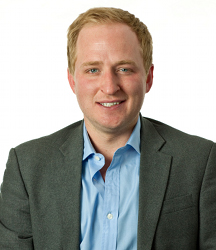
Ben Kennedy, group director of Mobile Marketing, Integer
The survey also revealed that nearly as many shoppers said they are using coupons from email and e-newsletters (49 percent) as said they are from the Sunday paper (57 percent). Respondents in households with children seemed more likely to overcome adoption barriers of digital technologies in favor of shopping solutions.
“Digital shoppers are just shoppers,” said Ben Kennedy, group director, Mobile Marketing, Integer. “Digital shopping tools are illustrative of the continued blurring of the on- and offline spaces. Today’s reality is that shoppers use whatever tools they have on hand to make them smarter, savvier shoppers.”
In the surveys, consumers were asked about their shopping attitudes, shopping behaviors, and economic outlook as well as the criteria shoppers use to select retailers, which in-store stimulus is most likely to drive purchase, and factors that might lead shoppers to leave an aisle empty-handed.
The Integer Group is a large promotional, retail, and shopper marketing agency, and a member of Omnicom Group Inc.
Posted by Elena del Valle on June 25, 2012
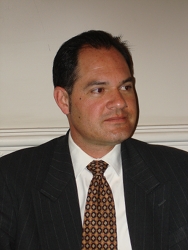
Heiner W. Skaliks, portfolio manager, SLAF
Photo: SLAF
A podcast interview with Heiner W. Skaliks, portfolio manager, Strategic Latin America Fund, is available in the Podcast Section of Hispanic Marketing & Public Relations, HispanicMPR.com. During the podcast, Heiner discusses investment opportunities in Latin America with Elena del Valle, host of the HispanicMPR.com podcast.
Heiner is also chief executive officer of Strategic Asset Management Ltd. Both companies are based in La Paz, Bolivia. He previously oversaw a diverse loan portfolio at Banco Mercantil S.A. Prior to that, he was chief executive officer and portfolio manager of a leading Bolivian mutual fund, and broker-dealer at a boutique investment bank where he created, managed and led a mutual fund company. He also led the development of the local capital market as a member of the board of directors of the Bolivian Securities Exchange.
To listen to the interview, scroll down until you see “Podcast” on the right hand side, then select “HMPR Heiner Skaliks,” click on the play button below or download the MP3 file to your iPod or MP3 player to listen on the go, in your car or at home. To download it, click on the arrow of the recording you wish to copy and save it to disk. The podcast will remain listed in the June 2012 section of the podcast archive.
Posted by Elena del Valle on June 22, 2012

Chef Carlos Rodriguez with Margarita Martinez, host of Neighborhood Kitchens, at Orinoco, a restaurant in Boston’s South End
Photo: WGBH
Last Sunday viewers of WGBH, a PBS station in Boston, had a chance to see the premier of Neighborhood Kitchens, the television content producer’s new 30-minute program about well known neighborhood eateries in the Massachusetts area. The season will have 12 episodes, each one profiling one restaurant in Boston and Cambridge, which will air for six weeks and resume with new episodes from September through October 2012. Producers hope to eventually find private sector sponsors and expand the geographic scope of the program to most of New England.
Filming began March 2012 and is scheduled to continue throughout the summer. The series initial season will feature a heavy Latin theme with cuisine from Venezuela, Brazil, Dominican Republic, Mexico and Peru as well as an Italian restaurant and a New American restaurant with menus heavily influenced by Latino executive chefs.
For inclusion, restaurants are “considered by their overall excellence in food and service, as well as having a significant tie to the neighborhoods they reside in. The restaurants featured are all established eateries, with very strong reputations in their communities; (they) are all excellent in the cuisine they present, as well as being part of the fabric of the neighborhoods they reside in; every restaurant chosen is really beloved by the residents in their neighborhoods,” according to a station spokesperson who indicated that suggestions for restaurants may be sent to the station.
The first restaurant featured was Orinoco, a popular Nuevo Latino Cuisine style restaurant with Venezuelan roots and three locations in Boston. During the 27-minute program, Chef Carlos Rodriguez demonstrates for viewers and the program’s host how three of his dishes are prepared: a portobello arepa (a Venezuelan style cornmeal dish) with Latin truffle (a corn fungus infused) cream, a salmon marinated in panela raw sugar and a torta fluida molten chocolate cake.
Bronx born Margarita Martinez, a trained actress and graduate from New York University’s Tisch School of the Arts, hosts the series. Patricia Alvarado Nuñez is the series producer and has the final word on restaurant selection.
Neighborhood Kitchens can be seen on WGBH in Massachusetts, and parts of New Hampshire and Rhode Island. Viewers can also see the episodes online at wgbh.org/neighborhoodkitchens after the primary broadcast play. The first episode is already available at wgbh.org/programs/Neighborhood-Kitchens-1859/episodes/Orinoco-in-Bostons-South-End-39469
Posted by Elena del Valle on June 20, 2012
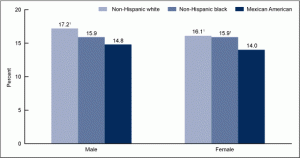
Sugar consumption children and adolescents 2005-2008 – click to enlarge
Chart source: CDC/NCHS, National Health and Nutrition Examination Survey, 2005–2008, CDC.gov
Restaurant owners, food makers and sellers listen up. Insufficient exercise, fatty and sweet foods were among the top concerns of Hispanic respondents to a November 2011 survey question by Mintel, a consumer, product and media intelligence company, about poor health.
Other concerns included eating too many processed foods as well as foods with too many calories or too much salt. The results of the survey of two thousand adults were released in Attitudes Toward Sodium US February 2012, a report by Mintel. The survey did not indicate if the respondents planned to take any action to modify their exercise regime or eating habits.
While Hispanic households spend less than mainstream households in general due to the larger size of Hispanic households (3.3 people compared to 2.5 people in the average non Hispanic home) Hispanics spend as much on groceries as the average household, according to Who We Are: Hispanics Second Edition (see Book outlines Hispanic population major characteristics).
It’s not clear whether the beliefs expressed by the Mintel survey takers are based on facts or perceptions and whether they apply only to adults. A study that used data from the National Health and Nutrition Examination Survey examined sugar consumption of United States children and adolescents between 2005 and 2008 (see Consumption of Added Sugar Among U.S. Children and Adolescents, 2005–2008 at CDC.gov and Mexican-American children eat less sugar than peers, says new study on NBC Latino) and indicated that Mexican American children “eat a smaller percent of calories from added sugars than their non-Hispanic white and non-Hispanic black peers.”
Posted by Elena del Valle on June 18, 2012

Melinda Lee, director, Getty Images Music
Photo: Getty Images Music
Getty Images, a leading creator and distributor of still imagery, video and multimedia products, as well as a provider of other forms of digital content including music with business customers in more than 100 countries, hopes to sell music to executives in the Hispanic advertising industry which the company’s executives believe represents more than a $5 billion industry. Getty marketing staff believe Spanish-language indie music is a “significant and largely unknown super-genre” that is growing “immensely in popularity and penetrating mainstream markets.”
Getty Images Music in partnership with MuuseMe is targeting United States content creators who service the Hispanic programming and advertising industry, the local Spanish language market, Latin America, Mexico and other Spanish speaking countries. The content creators in the United States represent about 75 percent of their target audience, according to a spokesperson.
“We’re committed to offering an affordable solution to this growing market, so that it can continue to grow without budgetary or creative limitations,” said Melinda Lee, director, Getty Images Music by email.
“The forward thinking team at Getty Images Music really gets what we’re trying to do here at MuuseMe,” said Rob Filomena, co-founder, MuuseMe. “Their international network allows us to offer our content partners multi-platform placement opportunities, and stay at the forefront of an important cultural trend by creating the first ever Spanish-language Indie production library.”
Getty Music has over 200,000 tracks. Through the partnership it will acquire an additional 3,000 tracks for a total of 10,000 Spanish language tracks when combined with its existing Spanish and Latin American catalog with Spanish-language indie music and indie bands that have Hispanic influences to be licensed through single and multiple track licenses, blankets and customized offerings by project. Price will be project and use based.
“We are promoting this highly valuable offering through media outreach efforts, on Getty Images digital platforms, social media and through our global sales and marketing force. We already know that our existing clients need this music so we are committed to getting the music to them,” said Lee in response to a question about channels the company is relying on to promote its new product line.
Examples of tracks that are available in the new collection include Plastics Revolution (Mexico), La Bien Querida (Spain) and Palenke Soultribe (Colombia). In addition to Getty Images Music’s existing Spanish and Latin American catalog with Spanish language indie music, the offering also includes English language indie bands that have Hispanic influences; and well-known Spanish and Latin American artists who are breaking into the United States market, according to Lee.
Posted by Elena del Valle on June 15, 2012
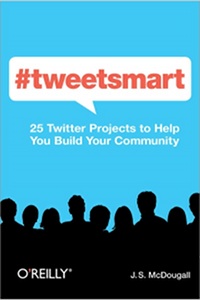
#tweetsmart book cover
Photo: O’Reilly
As social media fever continues nationwide figuring out how to participate in social media channels may be rising on the list of priorities of marketing departments. Twitter, one of the fastest growing social media sites, has become increasingly popular in business circles. Although many believe Twitter is not to be used for self promotion users write about their products and services all the time.
For example, the Swedish Institute and Visit Sweden, the government tourist agency, on the advice of a Volontaire, an advertising company, has recruited a different volunteer to be interesting, Twitter-literate and post in English each week. They have been the voice of the nation of nine million; and ranged from a high school student in Trollhattan, a town in western Sweden, to a 60 year old. Following the Swedish lead similar projects in Ireland, New Zealand and the city of Leeds in England are sprouting. (see Swedes’ Twitter Voice: Anyone, Saying (Blush) Almost Anything in The New York Times).
“The first tendency of most marketing teams is to transplant old strategies onto this new technology, which can be fatal,” said Jesse McDougall, a programer and web strategist from Vermont. “Would-be marketers on Twitter can do more harm than good in a very short amount of time. This new approach to marketing—one based in discovery instead of interruption—is only going to grow in popularity in the coming years.”
In #tweetsmart 25 Twitter Projects to Help You Build Your Community (O’Reilly, $19.99), an 85-page softcover book published this year, McDougall, discusses Twitter as a platform to connect with interested, influential people. He explores, in 25 short chapters, ways to meet and connect with others to build a community in ways that “are strategic, measurable and fun.” He shares several contest and promotional ideas, and discusses hashtag use, doing market research by inviting Twitter followers to share input, adlib, Haiku, discussion groups, Tweet Bombs, and photo sharing.
McDougall, who has 12 years of experience as a web designer, programmer, and web strategist, is author of eight books about conducting business on the web.

Click to buy #tweetsmart
Comments:
Filed Under: Books



























